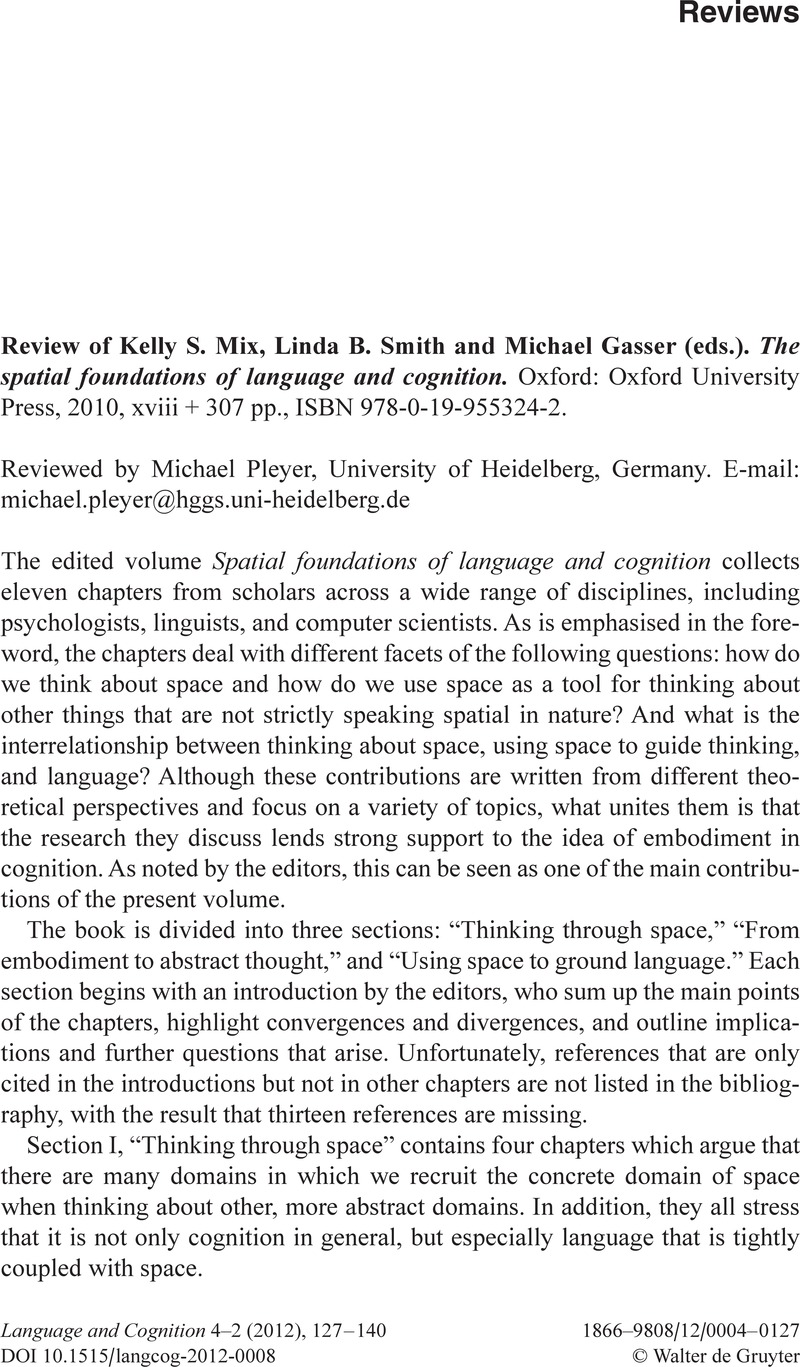No CrossRef data available.
Article contents
Review of Kelly S. Mix, Linda B. Smith and Michael Gasser (eds.). The spatial foundations of language and cognition. Oxford: Oxford University Press, 2010, xviii + 307 pp., ISBN 978-0-19-955324-2.
Published online by Cambridge University Press: 11 March 2014
Abstract
An abstract is not available for this content so a preview has been provided. Please use the Get access link above for information on how to access this content.

- Type
- Reviews
- Information
- Copyright
- Copyright © UK Cognitive Linguistics Association 2012
References
Baldwin, D. A.. 1993. Early referential understanding: Infants' ability to recognize referential acts for what they are. Developmental Psychology 29. 832–843.Google Scholar
Ballard, D. H., Hayhoe, M., Pook, P. K. & Rao, R. P. N.. 1997. Deictic codes for the embodiment of cognition. Behavioral and Brain Sciences 20. 723–767.CrossRefGoogle ScholarPubMed
Boroditsky, L. 2001. Does language shape thought? English and Mandarin speakers' conceptions of time. Cognitive Psychology 43. 1–22.CrossRefGoogle ScholarPubMed
Clark, E. V.. 1997. Conceptual perspective and lexical choice in acquisition. Cognition 64. 1–37.Google Scholar
Gonzalez-Marquez, M., Mittelberg, I., Coulson, S. & Spivey, M. J. (eds.) 2007. Methods in Cognitive Linguistics. Amsterdam: John Benjamins.Google Scholar
Johnson, M. 1987. The body in the mind: The bodily basis of meaning, imagination, and reason. Chicago: University of Chicago Press.Google Scholar
Lakoff, G. 1987. Women, fire and dangerous things: What categories reveal about the mind. Chicago: University of Chicago Press.Google Scholar
Lakoff, G. & Núñez, R.. 2000. Where mathematics comes from: How the embodied mind brings mathematics into being. New York: Basic Books.Google Scholar
Langacker, R. W.. 1987. Foundations of Cognitive Grammar, volume 1: Theoreticalpre-requisites. Stanford: Stanford University Press.Google Scholar
Moll, H. & Meltzoff, A. N.. 2011. Perspective-taking and its foundation in joint attention. In Eilan, N., Lerman, H. & Roessler, J. (eds.), Perception, causation, and objectivity. Issues inphilosophy and psychology, 286–304. Oxford: Oxford University Press.Google Scholar
Talmy, L. 2000. Towards a cognitive semantics, volume 1: Conceptual structuring systems. Cambridge: MIT Press.Google Scholar
Verhagen, A. 2007. Construal and perspectivization. In Geeraerts, D. & Cuyckens, H. (eds.), The Oxford handbook of cognitive linguistics, 48–81. Oxford: Oxford University Press.Google Scholar
Winter, B. & Bergen, B. K.. 2012. Language comprehenders represent object distance both visually and auditorily: Evidence for the immersed experiencer view. Language and Cognition 4. 1–16.Google Scholar
Zwaan, R. A.. 2004. The immersed experiencer: Toward an embodied theory of language comprehension. In Ross, B. H. (ed.), The psychology of learning and motivation, 35–62. New York: Academic Press.Google Scholar




